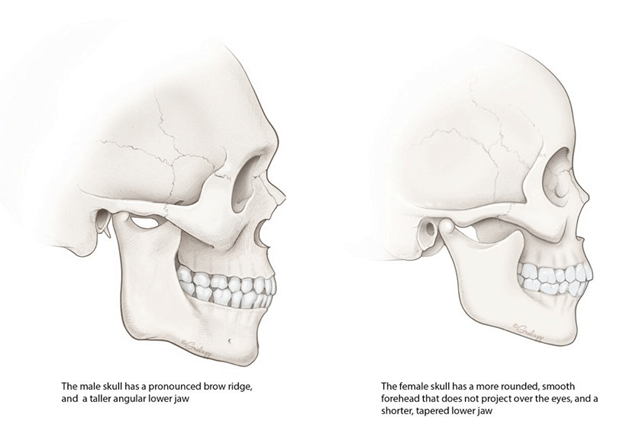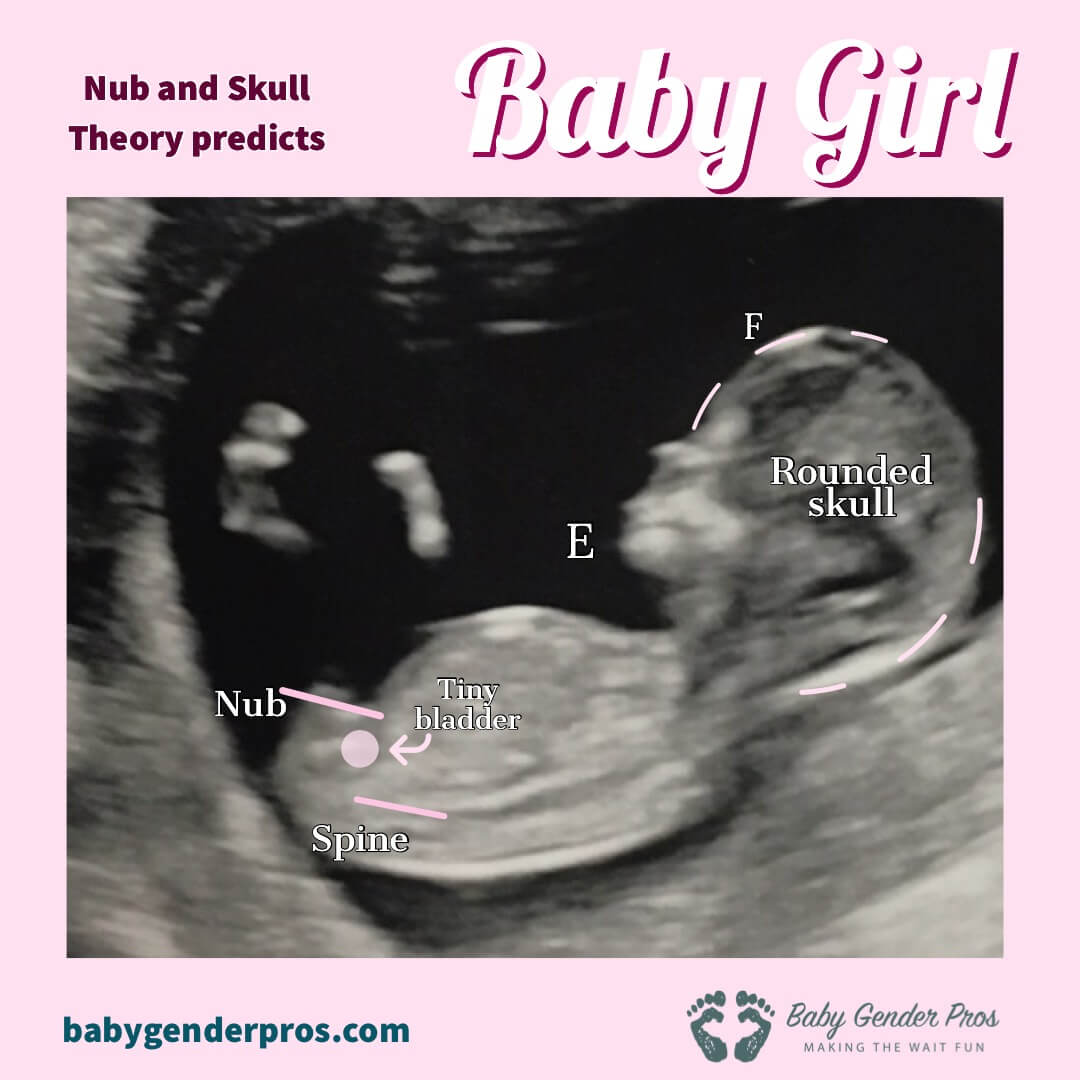The Skull Theory (Skull Gender Theory)
"Such a fun, simple way to get clues of the gender!"
- Happy mama.
What is the Skull theory gender prediction?
Skull theory is a gender prediction method based on the shape and size of the baby's head. This method has been used by many cultures worldwide.
Skull theory uses the bone structure of the baby's skull to determine whether it belongs to a male or female. This theory is based on the fact that male skulls typically have a more pronounced brow ridge, a squarer jaw, and more extensive mastoid processes.
Female skulls tend to be rounder with more delicate features. The size of the chin also plays a vital role in skull theory; males typically have broader, more angular chins, while females tend to have rounder, smaller chins.
Skull theory examples

Skull theory gender guidelines

For Skull theory gender prediction, Baby Gender Pros uses the following guidelines:
A) The male cranial mass is more blockyand massive compared to the females, which is rounder and tapers at the top.
B) Temporal Ridge – this runs along the outer side of the upper skull creating the square shaped of the upper head. More prominent in men than women.
C) A woman’s supraorbital margin (the ridge above the eyes) is sharper, while the males is round and dull.
D) The Zygomatic bone (the cheekbone that lies under the lower eye ridge) is more pronounced on the male skull.
E) The Mandible (lower jaw) bone of a woman is rounded, while the male’s is squared.
F) Frontal bone forehead structure terminates at the brow. The male forehead is lower and more sloping.
G) Men have a deeper cranial mass.
H) The supercilary arch is large and pronounced in the man.
I) A males gonion (most posterior inferior point on angle of mandible) is more flared out and sharply angled.
J) The teeth of men tend to be larger.
How Accurate is Skull Theory?
According to the supporters of this theory, skull theory is only about 65 percent accurate for predicting gender. While this method may provide some guidance in making a gender prediction, it is not foolproof and should not be used as a replacement for medical advice from your doctor.
Moreover, the accuracy of skull theory in discovering the baby's gender depends on the timeline. If it is done too early in the pregnancy, it may not be accurate since the baby's skull hasn't fully developed.
Timing of Ultrasound for Skull-Theory
If you want to know your baby's gender before you turn or reach 20 weeks through skull theory, you may want to consider a 3D or 4D ultrasound.
In this type of scan, the technician will look for certain skull features that are more pronounced in males than females. This is often done between 18 and 20 weeks into the pregnancy.
A consistent ultrasound checkup in your first 12 weeks will be very helpful in making the prediction. You should get at least two ultrasounds done before 20 weeks to ensure your baby’s skull has developed enough for a gender determination [1].
Claimed Skull Appearance for a Boy
According to the skull theory, you can determine that a baby’s gender is a boy if the overall shape of the skull is round and large, it is most likely to be a boy. Additionally, boys are believed to have pointed chins compared to girls, who usually have softer ones.

Claimed Skull Appearance for a Girl
On the other hand, the skull theory states that female babies tend to have a heart-shaped face with more defined cheeks and a soft chin. The forehead tends to be flatter than male babies, as well, as having smaller eyes and ears.

Advantages of Skulls Theory Gender Prediction
The main advantage of using the skull theory gender prediction method is that it can be used early in the pregnancy, as early as 16-18 weeks. This gives parents or expecting couples plenty of time to prepare for their upcoming arrival and plan accordingly.
Other advantages are as follows:- It is a non-invasive way to predict gender
- It has no known side effects
- It can be used without any medical intervention
Disadvantages of Skull Theory Gender Prediction
The main disadvantage of using the skull theory gender prediction method is that it’s not always accurate. Because skull sizes vary from person to person, it’s challenging to make an exact determination with this method. Additionally, some experts believe the accuracy rate is only about 65 per cent.
Another downside to the skull theory gender prediction method is that it requires a trained eye and experience to achieve an accurate prediction. Finding someone who knows how to measure skull sizes correctly can take time, as the size and shape of an individual's skull can vary dramatically. Even if you find a specialist familiar with this method, they may only sometimes obtain accurate results due to their own experience or lack thereof.
Skull Theory vs. Nub Theory: What's The Difference
If you're looking for ways to know your baby's gender in your womb, you might have heard of skull and nub theories. While both are gender prediction methods, there’s an essential distinction between them.
Nub Theory
Nub theory predicts the gender of a baby by looking at the developing genital area. It is believed that the genitals will protrude in boys and remain tucked into the body for girls, though this isn't always accurate. The nub theory's accuracy rate is around 70 percent, slightly higher than the skull theory's accuracy.
Moreover, nub theory can be used earlier in the pregnancy, as early as 11 weeks. This is because the genitalia develops during this time and can be seen on an ultrasound.
Skull Theory
Skull theory examines the shape and size of a baby's head during ultrasounds. Boys tend to have larger heads and more pronounced chins, while girls have smaller heads with softer chins, which may not always hold depending on each baby's features.
So, which one should you use?
It’s up to you to decide which gender prediction method you want to use. While there are no guarantees that either will be 100 percent accurate, many parents have succeeded with both skull and nub theories. Weighing the pros and cons of each may help you make a more informed decision about which one is right for you.
Is the skull theory worth it?
Overall, skull theory is a gender prediction method that can be used early on in the pregnancy to get an idea of what the baby’s sex may be. However, it’s important to remember that this method isn’t always accurate and should only be taken with a grain of salt.
A more reliable theory is the Nub theory, and more accurate ways of determining gender include amniocentesis or chorionic villus sampling (CVS). Other methods, such as blood tests and genetic screenings, are also available but require medical consultation with your doctor beforehand.
Finally, if you want to make sure that you know your baby's sex before they come into the world, it's best to talk to your doctor about different testing options available.
Determine Your Baby's Gender As Soon As Possible
At Baby Gender Pros, we can determine your baby's gender through skull theory ultrasound analysis. We will look at the differences between male and female skulls, such as the shape and size of the skull bones, as well as other subtle markers to make an accurate determination.
Our team of experienced ultrasound technicians have years of experience in baby gender identification and can provide you with a reliable result. With our advanced technology, we are able to provide gender identification as early as 16 weeks gestation.
We understand how important it is for you to plan your baby's arrival, and we are here to help. Contact us today for a consultation. We look forward to helping you in your journey to parenthood! Thank you for choosing Baby Gender Pros!
Skull Theory FAQs
Other gender prediction theories
Submit your review | |
Skull and nub theory perdicts of baby gender is correct
I first sent my 8 week scan, and U said girl for ramzi methode. Then I sent a front faced sonogram at 11 weeks, U said girl. Today I found out its a GIRL ! <3
Predicted a boy and having a boy!
Was a little dubious of the skull theory, but you were spot on. We had a little girl as predicted.
I was told I would have a girl and It was right I had a girl. I she is now 5 months old.
You were right with both the Ramzi and Nub Theory. Thanks.
Skull theory said boy and we had our 16 week scan which said boy!
Had our 6wk ultrasound looked at predicted girl in September we welcomed a baby girl!
I sent 2 scam pictures and they came back it was a boy they was right it’s a boy!!
At 11 weeks and 2 days I was told with prediction on Nub and Skull theory that it would be a baby girl, this was confirmed at my 16 week and 2 day scan! Baby girl 💗💞
I ordered the prediction for fun. All three theories said girl (11 week sonogram) NIPT test came back 2 weeks later confirming girl. But this was much cheaper! Im Impressed and very happy with results and fast turn around time. Thank you.
You were right! You predicted a girl based on the Skull Theory and sure enough we found out last week that it was in fact a baby girl! Thank you 🙂
Sent in my scan for skull theory. They predicted girl! They were absolutely right. After two boys we are getting our princess!!
Fun to play but I had two predictions from baby gender pros and Ramzi came back a boy, and Skull at week 12 came back a boy so i was shocked when it came true!!!.
I chose to have the Ramzi, Skull & Nub theory when I submitted my 13 week ultrasound photo...all 3 theories were predicted as a girl.
We just had our early gender scan today and you were right...it’s a GIRL!
Ramzi theory predicted a boy at 12 weeks, I did a 13 week nipt test, that confirmed a boy. I decided to do a skull test for fun you predicted a boy. I am happy to say with my 20week scan it’s a definite boy. It was fun playing.
Sent 13 week ultrasound for nub and skull theory, both predicted girl. 15 week ultrasound shows a baby girl, good job.
For both theories (Ramzi and Skull) you guessed girl. I was so excited to finally get my girl after two boys. Had a private ultrasound done to confirm, and the baby is a girl!. Very happy in the results here.
This was a fun service: our little one was predicted to be a girl using two of the theories. Our baby girl was born just a few weeks ago 😉
U said girl and i found out this month it was right


